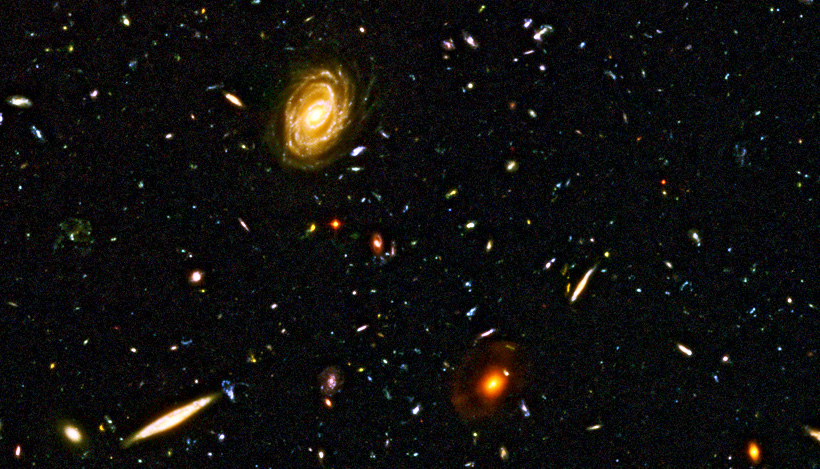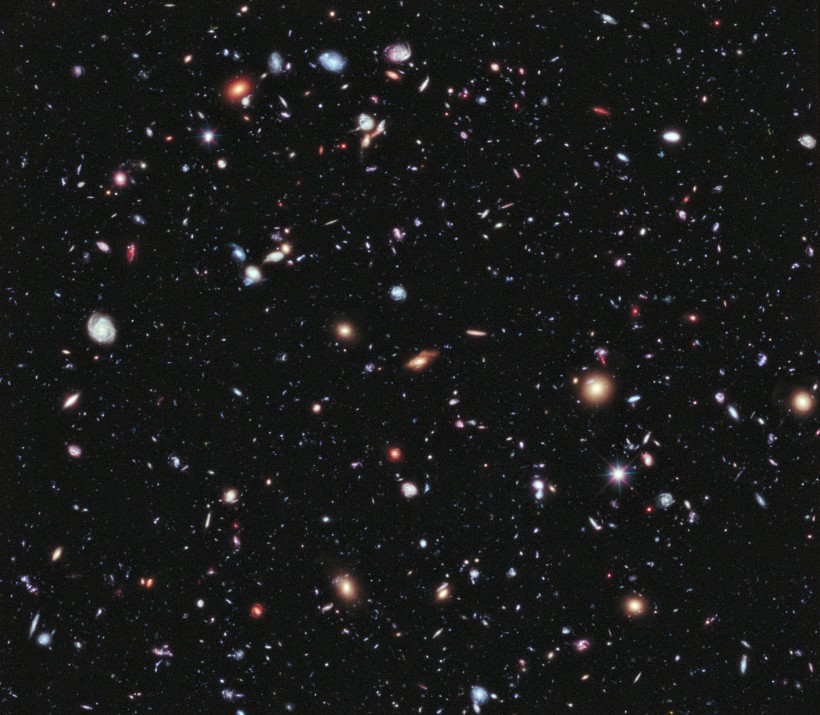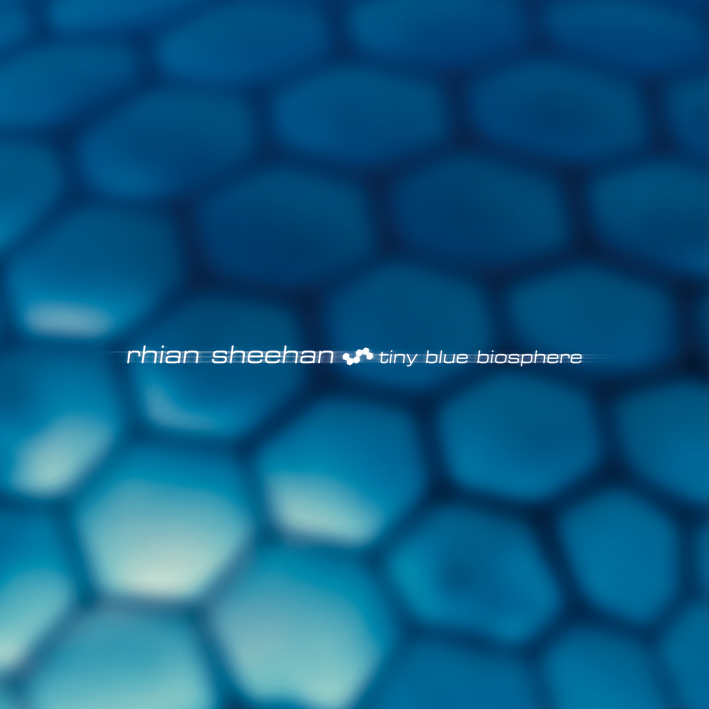Archive for October, 2012
Beginners Mind again, for this: The Hubble Extreme Deep Field
One of the first cosmological images which really and truly blew my mind as a young adult was the Hubble Ultra-Deep Field. Basically the idea was “Hey, what happens if we take our most powerful telescope and point it somewhere that’s pretty much empty and just stare at that spot for a really long time. What would we see?” The answer to that question was “We see somewhere in the neighborhood of 10,000 very distant galaxies.” Pause and let that marinate for a moment.
Here is a closeup on one small area of the image, a random part that I thought looked cool:

For a long time I left that as the wallpaper for my computer at work and I’d come in every morning and stare at the image while my slow computer took forever to finish loading windows. What was cool about having it as the wallpaper I had to look at while I waited for the machine to become usable was just how much there is to look at in there. As long as I stared at it, I’m certain there’s oodles of things I still didn’t notice. Looking at it first thing in the morning too, when the mind is raw and still gradually awakening surely added some awe to the effect as well. It’s staring into an abyss. Staring into infinity. And knowing that it stares back at you too…
As a humorous aside, I’ll note that the “Hubble Ultra-Deep Field” is actually the sucessor to the “Hubble Deep Field” which showed a different region in space. And this new image, the “Hubble Extreme-Deep Field” is a closeup of a smaller section within the Ultra-Deep Field image, adding around 5,500 galaxies to the original 10,000+. When the James Webb Space Telescope goes online, they have plans to image the same area with it’s mighty Infrared sensing capability. What will that image be called? The Ultra-Extreme Uber-Deep Field Tournament Edition Plus. Director’s cut. Enhanced, expanded edition. Two. Strikes Back. Reloaded. Chopped and Screwed. Remix. Turbo.
Whatever, it doesn’t matter what it’s called. Just, everyone, do me a favor: full rez this new baby and spend at least two minutes staring, thinking about what it shows:
Everything on the internet, everything in a book, everything you’ve ever heard, learned, imagined, or even dreamed, in the most remote recess of your subconscious, is all within the realm of the ‘Earth’ experience. And Earth is a single, small terrestrial planet out in some sleepy backwater arm of the Milky Way, a perfectly average spiral galaxy with about 300 billion stars, and about as many planets, with maybe 10 billion of these being in the goldilocks “habitable” zone. Or at least habitable to “life as we know it”. Nevermind moons, nevermind thermally-supported life, nevermind ‘Steppenwolf’ planets that were flung from their parent stars. If the entire breadth of human knowledge, emotion, and experience resides within our differential-unit-small grain of sand that’s floating in the Milky Way swimming pool, then try to concieve of the vast diversity of lifeforms, cultures, natural wonders, and sub-realities residing within the oceanic field of view of this image, depicting thousands upon thousands of distant galaxies. Try to imagine traveling there, surveying them. Imagine exploring just a handful of those galaxies and chronicling the habits of their residents.
How could we explore it? First we’d need to aggressively master interplanetary voyages, remote communication and colonization. Fly probes and listening devices to the Kuiper Belt. Mount them to passing comets for a long voyage back out to the Oort cloud. Use those to learn about the radiation and galactic wind in interstellar space. Develop shielding, life prolonging and hybernation capabilities for deep space travel. Contact alien cultures within our own galaxy and master inter-species diplomacy. Develop non-invasive, non-destructive ways to study primitive life still early in its evolutionary tree. Catch the best bacteria to help us live longer, retain more knowledge. Authoritively chronicle the Milky Way with billion-year data storage capability. Pool resources with other intelligences to build intergalactic ships or probes. Scatter them in all directions to search for points of interest. Then, finally, research ways to reach the most distant of galactic neighborhoods like the ones we see in these pictures. My point: The actual exploration of these places is not something that’s a few ‘ages’ away in terms of a civilization. Exploring these places is an act for intelligences unthinkably more sophisticated than our own… But we can dream of it.
When I look at this, I like to focus in on individual places and try to imagine what might be there. I like to find a pretty looking galaxy and think about what planets might be inside of it. Or sometimes find a teeny sub-pixel dot and wonder if that less-than-a-pixel point is a whole giant supergalaxy, burgeoning with life forms, interstellar commerce & conflict, culture & craftsmanship. Maybe these two galaxies colliding are locked in an interspecies war millions of years long. Maybe they’ve evolved organic-electronic synthetic intelligences that can instantly teleport between host bodies, allowing them to be anywhere their race has ever traveled instantaneously. I wonder what their music sounds like. I wonder what senses they have. Can they “see” radio waves? Does their culture have money, or government? I wonder what “pleasure” or “sex” means to them? Or consciousness? I wonder what THEIR telescopes have discovered about the formation of the cosmos. Does it look “the same in all directions” from the far-far edge of what we humans can see?
It’s fun to try envisioning all these things. And then humorous, in a zen sort of way, genuinely humorous, knowing that it’s impossible. You can’t. You’re looking at something so much bigger, ancient, and wilder than the capability of the feeble human brain to comprehend. The are not human words in any language to meaningfully describe what any of these Hubble Fields show. These images, obscured by the thick, nearly-opaque veil of distance, give the most fuzzy, teasing glimpse of something beyond us. Something beyond even what our most distant descendant will ever become. I find that deeply exciting. This picture shows, unquestionably, indisputably, that the universe has more to explore than is possible to explore. What better reason to be alive in this cosmos?
Vinyl Review: “Lonerism” by Tame Impala
I skipped writing a review on Innerspeaker, the first album by Australian psychedelic-rock band Tame Impala, because of a variety of reasons; it seemed like everyone already knew about it and I also did wonder if it was a one-off. Innerspeaker was an impeccably well written group of songs with such a delicious coating of 60s sheen that I doubted the band could replicate the same thing twice.
And with Lonerism they did not replicate it–they took the same sound and stepped a new direction, which is exactly what you want to see for the staying-power of an artist. Somewhere on the web I saw a critique of Innerspeaker that said “phasers were made for this album”. Troof! One thing Tame Impala fully excels at, is using reverb, delay, and them whirling, creamy phasers, to archetypal trippy effect. That heavy, dreamy phasing is back and sounding as good as ever here.
It should be mentioned right out of the gate that the mastermind behind the operation, multi-instrumentalist Kevin Parker, has seriously got to be a lost love-child of Paul McCartney. It would be an understatement to say his voice is eerily similar to a young Paul. It is a closer match than ‘uncanny’. Which is an integral part of the draw here–a magnificent centerpiece to the band’s palette, summarized on amazon as using “the aid of gear and production techniques that sounded like they hadn’t been dusted off since 1968”. Indeed, some of the cuts could probably fool a blind-listener into thinking some forgotten late-60s vintage gem of an LP was spinning on the turntable.
My favorite track on the album still has to be the aforementioned “Apocalypse Dreams” with a mesmerizing minimalistic breakdown at its center, lyrics that oscillate between hopeful or sarcastic, and giant, piano-pounding chords anchoring a fuzzed-out version of the lyric melody on guitar, forming a truly epic ending that seems to float off into the sky as the slow fade brings you out easy. They should have ended the album with this one. This is the only cut on the album which was jointly composed by Parker and bandmate Jay Watson; whatever flavor that’s being produced by the combination of these two minds, I hope to hear more of that in the future.
Possibly a close second for favorite track on this outing was “Mind Mischief” which makes prominent use of synths that sound more like something Neon Indian would use; a touch of 1980s Tears For Fears, in some sparkly, slow motion nostalgic way. Maybe Neon Indian would use that same synth, but they wouldn’t fully submerge it in the calling-card phaser/flanger treatment it gets here. The moment at 2:48 where the new chord progression starts is a particularly wonderful spot for me. There is a good deal of phasing leading up to that moment but right then it somehow gets even thicker and bigger. It’s a great example of ‘just when you thought they couldn’t take it to another level, they go and take it to the next level.’ I would really love to know what kind of gear they are using to achieve that rich, warm effect they are getting. Just Magical.
As an aside, isn’t the back cover art awesome? I included it here at full-res, so you can scan around the image and check out this mountain of toys he’s working. Sweet picture…
That same Neon-Indian-esque vibe is also present in spades on “Why Won’t They Talk To Me?” and it works well. The infusion of this synth-heavier, vaguely 80s influence is what I was alluding to at the start when I mentioned a new direction for the style. I dig it. There were maybe hints of this on their first album, but Lonerism brings it to the fore. Another overarching theme here is the great usage of pauses in the music, where there is a short interval during which all instruments stop playing, only to resume in unison a second later. That’s a classic ‘cheap trick’ in songwriting that always works.
 A major feather in the cap of Innerspeaker was the fact that it was 100%. No filler songs, no fluff, no annoying tracks you will skip every time they come up. They didn’t quite achieve the same level here, although the mark wasn’t missed by far. “Sun’s Coming Up” is sort of an amateurish-sounding screw off that offers a view of what sounds like Kevin messing around in the lab/practice room. Which is maybe interesting on that level, but it sticks out like an awkward sore thumb when placed next to all the finished-sounding polished compositions preceding it. The fact that this whimpering should-have-been-a-B-Side closes the album is regrettable–this is not the conclusion it deserves. “She Just Won’t Believe Me” is also something of an odd interlude that’s not really a song. And the constant plodding quarter note chords on every single beat of “Keep On Lying” can definitely get old. I like to picture ‘keyboard cat’ playing that background part. Hahahaha
A major feather in the cap of Innerspeaker was the fact that it was 100%. No filler songs, no fluff, no annoying tracks you will skip every time they come up. They didn’t quite achieve the same level here, although the mark wasn’t missed by far. “Sun’s Coming Up” is sort of an amateurish-sounding screw off that offers a view of what sounds like Kevin messing around in the lab/practice room. Which is maybe interesting on that level, but it sticks out like an awkward sore thumb when placed next to all the finished-sounding polished compositions preceding it. The fact that this whimpering should-have-been-a-B-Side closes the album is regrettable–this is not the conclusion it deserves. “She Just Won’t Believe Me” is also something of an odd interlude that’s not really a song. And the constant plodding quarter note chords on every single beat of “Keep On Lying” can definitely get old. I like to picture ‘keyboard cat’ playing that background part. Hahahaha
But we’re delving into nickpickery now. Viewed from afar, Lonerism is a glorious, billowing flag planted atop a sand dune on a sunny afternoon at the beach. That is to say it’s magnificent. I have been looking forward to the release of Tame Impala’s second album ever since I heard the unimpeachable Innerspeaker, and it’s with a combination of relief, intrigue, and delight that I say they’ve got a worthy sequel here. As I’ve grown older, the amount of new rock music as a percentage of my music collecting has frankly plummeted Blame it on a perpetually diversifying taste for different genres and styles, blame it on oversaturation as a youngster with cookie-cutter bands that all used the same radio-friendly hard-rock formula, blame it on the sheer number of bands which use bass/drums/guitar/vocals, maybe a keyboard… and never anything else. Maybe I’ve gotten bored with it, maybe I need more variety, or maybe for me to enjoy rock like I once did, it has to have some kind of compelling ‘twist’ beyond the plain-vanilla form.
Tame Impala has that compelling twist, in the form of a young Paul McCartney doppelganger, spot-on vintage mastering, unparalleled tastefulness with rich phasers, and solid songwriting to showcase their novel, psychedelic sound that leans heavily on late 60s rock influences; the progenitor of the whole genre to begin with. These guys have gone back to the source and tapped into something equivalently timeless as it is overlooked in the sprawling “rock” section of today’s music stores. This band is something special, and I hope they produce many more excellent offerings along the path set forth by these superb first two.
Revisiting some gadgetry that caught my eye
 Looks like Motorola has killed off the Webdock, citing insufficient demand. I’m definitely guessing it was simple pricing that killed it. $500 (later $150) for what essentially amounted to a hollow shell that projected your phone onto a bigger screen; that just won’t fly in today’s world of Android tablets that cost around the same price. I still think it was a cool idea; a multimedia-friendly dock that turns the content on your phone into something more akin to a laptop. But apparently it just wasn’t meant to be. Bon Voyage, webdock! We hardly knew ye.
Looks like Motorola has killed off the Webdock, citing insufficient demand. I’m definitely guessing it was simple pricing that killed it. $500 (later $150) for what essentially amounted to a hollow shell that projected your phone onto a bigger screen; that just won’t fly in today’s world of Android tablets that cost around the same price. I still think it was a cool idea; a multimedia-friendly dock that turns the content on your phone into something more akin to a laptop. But apparently it just wasn’t meant to be. Bon Voyage, webdock! We hardly knew ye.
Incidentally, I still think tablets are stupid; an awkward in-between format that tries to combine laptop with phone but has the best of neither. Apparently I am far from the only one either. A very solid chunk of my random Google searchers wind up here to laugh at that derisive photo of Steve Jobs holding up four iPhones duct-taped together. Still relevant!
And, about half a year after complaining that I was craving a new phone, guess what, I still have the same phone! Last time around I was debating the merits of the Lumia 900 and the Galaxy Note. Well come November both of these will have sequels (the Lumia 920 and the Note II respectively). Switching from iPhone to Android was cool because it was a change in ‘vibe’. That wording maybe oversells it, but I did enjoy a ‘fresh take’ on what a phone should be like. I am still interested in turning the page yet again when it comes to smartphone interaction, so I was closely following Microsoft’s take, but now it appears that the Lumia 920, the win-phone king for 2012, will be an AT&T exclusive, because in the over-dramatic-but-maybe-somewhat-true words of Gizmodo “Verizon hates you and everything you love”.
 That leaves me with the Note II, which is supposed to come to big red. A Wacom-designed stylus that has deeply-integrated support baked-in to the whole software sounds like it could really affect the ‘feel’, and possibly even what you do on it. 1024 levels of pressure sensitivity will definitely make for some bomb sketching. I do anticipate that there will be times when the large size is an annoyance, but still. I think the Note II should offer an unusual day-to-day interaction which I’d like to check out for a few years. I’m betting whatever I eventually replace it with years down the road will probably return to being normal-sized… But for a while, I’d like to live with it and see what a monstrous fiver is like. Begin the countdown now!
That leaves me with the Note II, which is supposed to come to big red. A Wacom-designed stylus that has deeply-integrated support baked-in to the whole software sounds like it could really affect the ‘feel’, and possibly even what you do on it. 1024 levels of pressure sensitivity will definitely make for some bomb sketching. I do anticipate that there will be times when the large size is an annoyance, but still. I think the Note II should offer an unusual day-to-day interaction which I’d like to check out for a few years. I’m betting whatever I eventually replace it with years down the road will probably return to being normal-sized… But for a while, I’d like to live with it and see what a monstrous fiver is like. Begin the countdown now!
I think it’ll be sweet!
Very much looking forward to the next SimCity
I spent a straight-up disgraceful amount of time playing SimCity 2000 back in the day… “reticulating splines…”
So yeah, I’m excited about what they show in this gameplay trailer:
Looks like 2013 is shaping up to be a great year of strategy/simulation
Album Review: Tiny Blue Biosphere by Rhian Sheehan
Like “Arboreal” by The Flashbulb, this album is one that immediately seized me and has maintained a lasting draw, despite the fact that there are a few tracks on here that are definite throw-aways for me.
This album came out in 2004 and the album name suggests the tone within; a whole lot of riffing on space and cosmology. But unlike, say, Symphony of Science, this guy makes use of wickedly cool nerd samples without being cheesy about it. I do love me some Symphony of Science, but let’s be honest; it’s cheesy. What’s on this album is a hipper approach to melding science and music…
I should clarify what I said in the opener: the tracks on here with the female vocals really sound dated, to my ear. They’re something reminiscent of 1990’s BT production. Which I listened to maybe a few times too many and now I’m just finished with that sound. So perhaps to someone else, those cuts wouldn’t grate as hard.
But oh man, when Sheehan gets it right, he nails it. And in a way that I’m super into. It’s electronic music through and through, with something interplanetary in the sound palette. It shares that “we’re totally in outer space while we’re listening to this” vibe that Visit Venus had, but it’s not a retro 60s sound, it’s more of a late 90s, early 2000s electronica sound. Upon hearing this album, I went and checked out the rest of his catalog, but was unable to find anything like this album (again like the Flashbulb, the thing I latch onto seems to be a one-off).
Sheehan makes good use of ambient sounds. Which makes sense because film scores are apparently his main thing. The intro track to the album is a dreamy ambient affair with the muffled sounds of airport announcements in the background. It’s something that sets the tone, making you feel like we’re about to depart somewhere. Somewhere dreamy.
Track two busts right into the meat. Carl Sagan’s distinctive inflection questions: “How… Did the Universe… Arise? …. What was around… Before that? … Might there have beennn. No… beginning? … Could the Universe be… Infinitely. Old?” There’s some kind of surreal but subtle effect on his voice too that seems to precede his words in a captivating way. Then the beat drops and Carl Sagan gets peppered around for a while as the vibe marinates. At 1:50 when that first quote gets reintroduced, it feels good; like it’s something you could be piloting a futuristic space fighter over the surface of an alien world to, looking all badass.
Track four, Phobos, weaves together a lovely multicolored yarn of samples, with subtle piano, hand drums, etheral vocals, and maybe a couple other electronic sounds I can’t put my finger on. Then it ends with this long-ass movie quote with minimal music behind it, neither building up nor breaking down, which something which I always find tedious (I’m looking at you James Warren). Fortunately this long-winded speech is the exception to the rule on this album.
Cut number seven, entitled “Cosmology” opens up with a set of 4 repeating chords from a string section, building into a grooving lounge-type beat with vibraphone and guitar. And booyah, Carl is back, this time offering “the current scientific story of the universe” in which he explains the big bang theory as only he can. Although it certainly doesn’t hurt that Carl has masterful oratory skillZ (that’s skills with a capital Z), I think a key component here is the fact that the music builds and swells along with what he is talking about. The energy changes as his discussion goes on, which is kind of a fascinating format that I wish I knew more examples of. It’s like a long speech about interesting things, wrapped inside of a changing groove that switches density to add or subtract emphasis from the speech. That’s in contrast to what I was complaining about before, where a long expository quote tramples over the music; the equivalent of a one sided conversation where the music just can’t get a word in. That the music flows in tandem *with* the oratory is a pivotal distinction.
“Degrees of Freedom” is also worthy of note; a pleasant, flowing groove that uses acoustic guitar above a mellow four on the floor beat.
And then there’s my favorite jam on the album, called “System”. We hear astronaut samples for the first time, and it works so beautifully I really wish there were more cuts just like this. The song uses acoustic guitar and strings alongside a series of synthetic sounds in a very impressive melding of these disparate elements. The mood it sets is one perfectly suited to the “magnificent desolation” as Buzz Aldrin described. A kind of yearning but still graceful and full of wonder.
This is a great album, full of musical cues that transport the mind on a journey across space and time, unlike anything else I can name. The two tracks marrying Carl Sagan samples with sweeping music that neither overwhelms his words, nor falls limply behind them–all while avoiding coming off as cheesy–make it a memorable listen alone. That Sheehan goes on to populate his odyssey with other compositions which stand on their own merits as clever sci-fi/science-y mashups make this album required listening for all nerdy types. This one is a touchstone for me, for all the reasons detailed herein.






